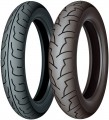Width
Nominal tyre width (section width) in millimetres. This is one of the notation options; in addition to it, there may also be a designation in inches, for more details, see "Width" above.
Width — whether in millimetres or inches — is one of the parameters that determine compatibility with a particular rim (the other parameter is the fit diameter, see above about it). The main criterion for choosing a tyre in width is the manufacturer's recommendations for a given motorcycle model. It is highly undesirable to deviate from these recommendations: although some types of motorcycles (for example, road bikes) allow a width deviation of +/— 10 mm on the rear wheel, such a wheel will still function in a mode that differs from the standard one. On the front wheel, no deviations are allowed at all.
Load index
The load index indicates
the maximum weight load that the tyre can safely carry in normal operation. To shorten the marking, this parameter is denoted by a two-digit number; you can translate this designation into a specific weight in kilograms using special tables.
This value must not be exceeded — otherwise the tyre may burst at any time due to off-design loads. At the same time, when choosing motor tyres for this parameter, it is worth remembering that the load is distributed unevenly between the front and rear wheels. However, the task is facilitated by the fact that motorcycle manufacturers can indicate the minimum or recommended load indices for the front and rear axles in the documentation for their equipment.
Speed rating
The speed rating characterizes the maximum speed at which the tyre maintains performance, in other words, the highest speed at which you can safely drive when using this tyre in normal mode (on the “native” axle, with normal load, etc.). This parameter is indicated by Latin letters, each of which corresponds to its own maximum speed value — for example, a value of 210 km/h is denoted as H. The most modest modern tyres, used mainly for scooters and motocross motorcycles, have the index J (100 km/h), and in high-speed sports models there are models of the
W level (270 km/h).
You should choose a tyre for this parameter based on the recommendations of the motorcycle manufacturer, and if there are no such recommendations, then with a margin of at least 10-15 km/h in excess of the maximum speed with which you plan to ride; this will give an additional guarantee of safety in case of emergency situations. It is technically OK for most motorcycles to use tyres that are less fast than recommended, but in fact this should not be done. And the point is not only that the driver will have to limit the speed of movement — such tyres are generally less durable than high-speed ones and may not tolerate sharp accelerations well.
Design
The design of the tire depends on the arrangement of the cord threads - a special fiber that gives the rubber base additional strength and rigidity.
-
Radial. In radial models, the cord fibers are located across the tire, parallel to its radius. Such tires are not as prone to heating up as diagonal tires, so they can easily provide a high speed rating (see below). At the same time, radial models are poorly adapted to high weight loads, and their profile is generally flatter and lowered. Therefore, a similar design is found mainly in high-speed tires for sports and road use (see “In the direction”), intended for sport bikes and other relatively light equipment. However, enduro class models can also use this option; but among cross-country ones it is practically not used.
-
Diagonal. In bias-ply tires, the fibers are arranged in the form of a characteristic grid, intersecting each other at an angle of about 40–60°. Such tires heat up more when driving than radial tires, which is why they are poorly suited for high-speed driving. On the other hand, the bias-ply design makes it possible to create high-profile tires with a high load index that can withstand driving well on uneven roads. Therefore, this particular option is used in road tires designed for heavy equipment such as choppers and cruisers, as well as in cross-country models.
Reinforced / RF
Reinforced tyres with extra ply cords to provide increased load capacity and withstand high loads. Such tyres are marked with the designations Reinforced, REINF or RF.

